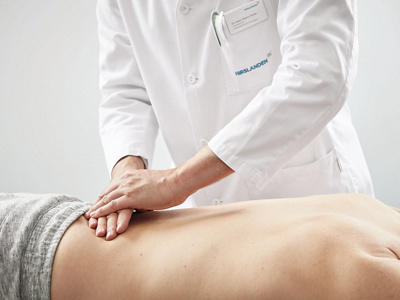Lumbago refers to a sudden, stabbing back pain that typically affects the lower back (lumbar spine). It is usually caused by muscle tension resulting from a sudden jerking movement, or improper strain on the spine.

Lumbago at a glance
The term ‘lumbago’ is closely linked to the folk beliefs of the Middle Ages. At that time, unexplained pain and the hunched posture associated with the condition were often attributed to magical or supernatural causes. The sudden pain in the lower back was therefore thought to be the result of being magically stabbed by a witch (in German the disease pattern is also called "Hexenschuss").
Causes and risk factors
The cause of lumbago (or lower back pain) is usually sudden muscle tension or a strain caused by making the wrong type of movements such as heavy lifting, quick turns or sitting for long periods of time. Although lumbago usually comes on unexpectedly, certain risk factors may lead to the occurrence of lumbago:
Degenerative diseases of the spine
These include herniated discs and calcification of the vertebral joints, which can have a negative effect on the structures of the lumbar spine and lead to muscle tension.
Weak back muscles
Insufficient strengthening of the back muscles can make the back less stable and more prone to injuries such as lumbago.
Poor posture
Poor posture, especially when sitting or standing for long periods of time, may put excessive strain on the muscles in the lower back and result in lumbago.
Wear and tear
As people age, signs of wear and tear can occur in the spine, increasing susceptibility to muscle tension and strains.
Psychological distress
Stress, anxiety and other forms of psychological distress can also cause increased muscle tension in the back and thus increase the risk of lumbago.
Physical illnesses such as flu
Illnesses such as flu can lead to general weakness and a weakened immune system, which can contribute to muscle tension and possibly to lumbago.

Symptoms
Generally, the back pain associated with lumbago occurs suddenly and is very severe. It often occurs in connection with a twisting or bending motion of the back. The pain is localised in the lumbar vertebrae and is accompanied by tension and a hardening of the back muscles. Movement in the back is severely restricted as a result of the severe pain and tension in the muscles. In most cases, lumbago makes it almost impossible to straighten the back.
A herniated discand sciatica are often accompanied by additional symptoms such as radiating pain, numbness or muscle weakness in the leg.
Diagnosis
An orthopaedic specialist is normally able to diagnose lumbago based on the characteristic symptoms. The circumstances of the incident are determined, the area of the pain is located, and the restrictions on movement are checked by taking a thorough medical history and performing a physical examination.
Imaging techniques such as X-rays can be used in some cases to confirm the diagnosis and help to identify possible degenerative diseases of the lumbar spine.
Treatment
The treatment of lumbago aims to relieve the acute pain in the lower back and restore the patient’s mobility. Usually, the following measures can be used to treat lumbago, with the choice of treatment approach depending on the severity of the pain in the lower back and the specific needs of the patient:
Rest and recuperation
Typical measures include resting and protecting the affected region to avoid further strain.
Medication therapy
As part of the treatment of lumbago, anti-inflammatory drugs such as ibuprofen can be used to relieve pain.
Heat and massage

Physical measures, such as heat treatments or massages, can be used in a targeted manner to relieve muscle tension, promote blood circulation and thereby help ease pain and relax the back muscles.
Physiotherapeutic treatment approach
Measures involving physiotherapy such as targeted exercises to strengthen the back muscles and to improve flexibility are also important to support recovery and prevent any recurrence.
Complementary therapies
In some cases, complementary therapies such as electrical stimulation, acupuncture and chiropractic treatment may be considered in order to alleviate the symptoms of lumbago.
After the acute pain has subsided, it is advisable to do stretching and relaxation exercises. Targeted muscle training and learning how to correctly lift heavy loads can help to prevent lumbago.
Prevention
Prevention of lumbago focuses on strengthening the back muscles and avoiding placing excessive strain on the spine. Strengthening the surrounding muscles, improving posture and lifting technique, as well as relaxation exercises, help to prevent lumbago.
Strengthening the back and abdominal muscles

To prevent lumbago, it is important to train your back muscles regularly. Targeted exercises that strengthen both the back and abdominal muscles help to stabilise and support the spine.
Posture and lifting technique

Maintaining good posture and using the correct technique when carrying heavy loads helps to avoid excessive strain on the spine. Ergonomic adjustments in the workplace and in daily life, such as using a height-adjustable desk or lifting heavy objects using your legs instead of your back, can help with this.
Stretching and relaxation exercises
Performing exercises regularly in order to relax and stretch the back area not only helps to deal with lumbago that has already occurred, but also actively helps prevent tension and promote flexibility in the back muscles.


